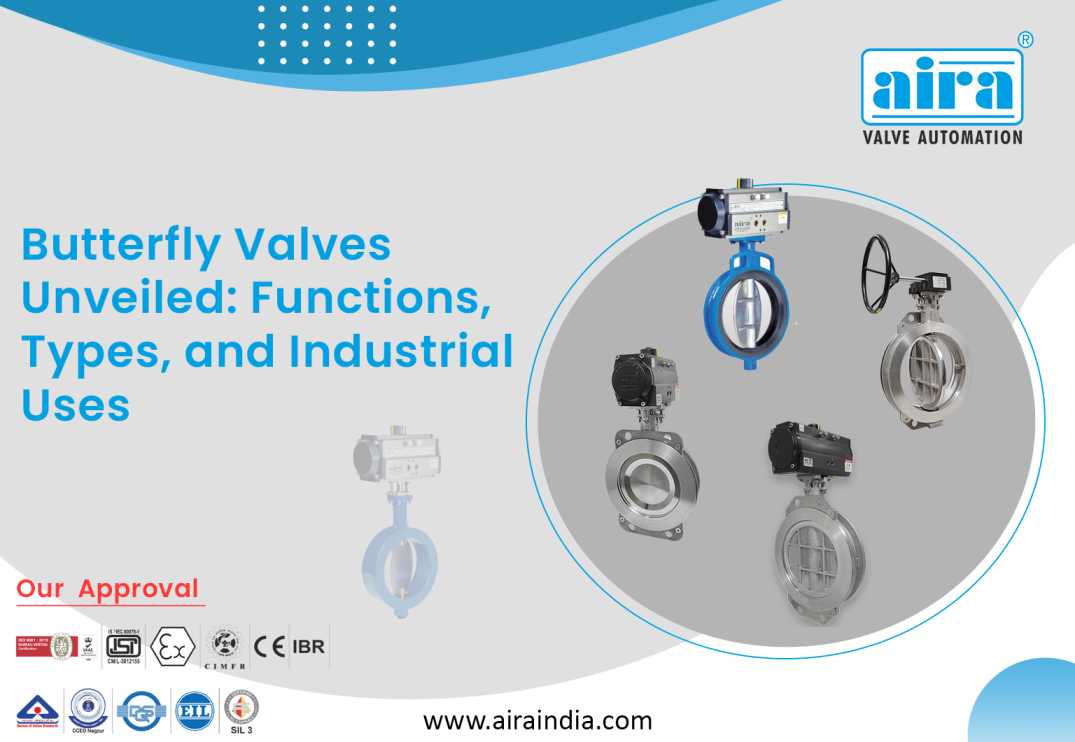Butterfly Valves Unveiled: Functions, Types, and Industrial Uses

Explore the complicated global of Butterfly valves in this guide, which explains their features, types of Butterfly valves, and industrial uses. These modern Butterfly valves are important in regulating fluid control appropriately. We study many types, ranging from robust seats to high-performance designs, and shed light on their distinctive features. Learn how these flexible valves perform critical roles in industries ranging from water treatment to chemical processing.
Explore the excellent range of Butterfly valves at Aira Euro Automation, we are the leading Valve Manufacturer in India.
What is a Butterfly valve?
A Butterfly valve is a quarter-turn rotational valve that controls the flow of fluids in a piping system. It features a rotating disc controlled by an external actuating mechanism. The valve can be fully obstructed when the disc is coplanar to the flow cross-sectional area, or partially allowed. Butterfly valves are compact, simple, and can be operated manually or automatically. They are suitable for on-ooff applications but have limited applications for flow throttling.
Functions of the Butterfly valve
When the Butterfly valve is fully opened, it has a small flow resistance.
The butterfly valve when fully opened, offers small flow resistance and sensitive flow control, which makes the valve common in large-diameter regulation. It is suitable for suspended solid particles, powered, and granular media, depending on seal strength.
A butterfly valve is suitable for flow regulation.
Because the pressure loss of the Butterfly valve in the pipeline is quite high, it is approximately three times that of the gate valve. As a result, while selecting a Butterfly valve, the impact of the pipeline system’s pressure loss should be completely considered, as well as the strength of the Butterfly plate under the pressure of the pipeline medium when closed. Furthermore, the operating temperature restrictions of the elastomeric seat material at high temperatures must be addressed.
The butterfly valve has good fluid control characteristics.
With its small construction, fast opening and closing, and excellent fluid control, the Butterfly valve is perfect for large big-diameter valves. It is critical to choose suitable specifications and types from a professional industrial valve supplier to ensure effective flow control and proper functioning.
Industrial Uses of Butterfly Valves
Food Processing
Modern Butterfly valves are used in the food processing field to provide efficiency, cleanliness, and control. These valves are simple to clean, maintain, and regulate quality and safety. They can control the fluid flow easily and have an adjustable range of 90 degrees. These valves are religiously tested to verify their suitability for the work. They are especially convenient for employees who have food allergies or dietary constraints. The design of Butterfly valves reduces cleaning time and expenses in the industry.
Oil & Gas Refineries
triple -offset valves (TRVs) are critical in offshore oil and gas refineries because they can withstand extreme temperatures, pressures, and media. Butterfly valves offer dependability, low maintenance, and extended life. They are durable, heavy-duty, and efficient in both critical and non-critical refinery applications. They provide zero leakage and pressure ratings up to ASME Class 1500.
As Shut-off Valves
A butterfly valve is a type of shut-off valve used in industrial applications that provides a better seal and bubble tightness. It is lightweight, simple, and adaptable, and is used to regulate flow and halt fluid in large-diameter pipes. Available in a variety of designs and sizes to accommodate varying pressures and applications.
In Ship Building
Butterfly valves are dependable and long-lasting in power-generating industrial applications, especially when made of ABS. they generate water-tight shut-offs in pipework, which makes them ideal for use in restricted locations on ships. They are utilized in jack-up rigs, ballast systems, firefighting equipment, domestic pipes, and capacity lines.
The Types of Butterfly Valves
Wafer Types
The Wafer body is enclosed between two pipe flanges, and flange bolts surround the valve body. A wafer-type butterfly valve is easy to install, but it cannot be used as an isolation valve. Aira Euro Automation offers the best quality Butterfly valves, explore Wafer type butterfly valve range here.
Lug Types
The Lug body features extending lugs around the body that allow bolt holes to match those in the flanges. Aira Manufactures high-quality Rubber Lined Lyg Type Butterfly valves.
Double Flanged Butterfly Types
The double flange butterfly valve, with two flanges, offers stability and security in high-pressure applications. Common options include double offset and triple offset. Flanged valves are resilient seated and non-replaceable, which makes them ideal for tight seals in water treatment plants and chemical processing facilities.
Triple Offset Types
Triple offset butterfly valves have three offsets: between the disc and stem, disc and seat, and seat sealing surface. They eliminate rubbing, reduce seat, and seal wear, and ensure smooth operation. They are commonly used for metal seats and tight shut-offs and can be operated and closed quickly. The third offset makes the valve a torque-seated valve.
FAQs:
What is a Butterfly valve?
Butterfly valves are used where space is limited. Unlike gate valves, butterfly valves can be used for throttling or regulating flow as well as in the fully open and fully closed position. The pressure loss through a butterfly valve is small in comparison with the gate valve.
What is a wafer type of butterfly valve?
Wafer-type Butterfly valve has a compact, disc-shaped body with sealants placed at the edges to form a leak-proof joint between pipe flanges.
What are the uses of Butterfly valves?
Butterfly valves are used where space is limited. Butterfly valves can be used for throttling or regulating flow as well as in the fully open and fully closed positions.
How does a Butterfly valve work?
Butterfly valves are quarter-turn valves that are best used to open or close the flow of media in pipelines. When the valve handle is turned 90’, it either opens or closes completely.